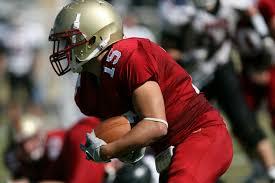When writing about this topic three weeks ago, our focus was mostly on the failure of high schools to protect student-athletes from potentially-fatal heat stroke.
Little did we know what the big boys – for a much longer time – were failing to do as well.
With a key preventive measure being so simple – the availability of a tub full of ice water – it defies all logic that this simple step isn't being taken everywhere strenuous workouts are being held.
But now comes the revelation that NCAA football players are being worked so hard during practice that they've been regularly dying of heat stroke since the beginning of this century.
This week, the HBO newsmagazine show "Real Sports with Bryant Gumbel" reported that "since the year 2000, 30 players have died as a result of college football workouts." The cause: heat stroke, which is completely preventable if college officials overseeing grueling practices – usually athletic trainers – can identify a stricken player's physical distress while it's happening and immediately have him immersed in a nearby ice bath.
Yes. Thirty dead players in 18 years, or nearly two every year.
And inevitably, when grieving parents ask what could have been done to prevent such a senseless tragedy, they are always – always, 100 percent of the time – presented with this overlooked remedy. A solution so simple, in fact, that is must make their loss even more painful.
"A tub, ice and water would have saved their child's life. That simple," states Dr. Douglas Casa, who is "among the leading experts of sudden death in sports," according to correspondent Jon Frankel. "It will save their life, every time."
And yet, having icing tubs available during practice is not mandated by the NCAA.
Even more frustrating, HBO's Frankel revealed that Dr. Casa, who leads the Korey Stringer Institute, a leading organization on heat stroke and its link to player fatalities, has collaborated with colleagues in drafting a list of specific recommendations that detail how these type of fatalities can be prevented.
 The document, "The Inter-Association Task Force for Preventing Sudden Death in Collegiate Conditioning Sessions: Best Practices Recommendations," was sent in 2012 to the NCAA, which has failed to enact the practices, in their entirety or even partially. The organization said the changes would be too difficult for member colleges and universities to implement. (photo of Dr. Casa courtesy: Korey Stringer Institute)
The document, "The Inter-Association Task Force for Preventing Sudden Death in Collegiate Conditioning Sessions: Best Practices Recommendations," was sent in 2012 to the NCAA, which has failed to enact the practices, in their entirety or even partially. The organization said the changes would be too difficult for member colleges and universities to implement. (photo of Dr. Casa courtesy: Korey Stringer Institute)
In the meantime, college football players continue to die from heat stroke. Most recently it was Jordan McNair, a 19-year-old at the University of Maryland, whose core body temperature soared to 106 degrees during a May 29 workout while undergoing intensive conditioning that included repeated 100-yard sprints. The freshman was not placed in an ice bath while awaiting EMTs and died 15 days later.
In addition, there's this: "The rise in the deaths during workouts has corresponded with another sharp rise," Frankel noted, "the rise in the prominence and pay of strength and conditioning coaches." Men in these positions have been given ever-greater influence to push football players to their physical limits, and they've been doing just that.
But Frankel tells us that there's one substantial shortcoming with their professional education in this field: strength and conditioning coaches can get certified without learning anything about player health. All they have to do is pass a 13-hour course – one that includes no safety training at all.
"The deaths, at this point in time, absolutely it's predictable. They're going to occur. It's disturbing. It's really inexcusable," said Scott Anderson, the longtime athletic trainer for the University of Oklahoma. "Without question, the role of the strength and conditioning coaches has grown over time. There should be some accountability that comes with that."
In the wake of these 30 deaths, the NCAA has yet to mandate any safety or medical training for strength and conditioning coaches, HBO reports. And not one has ever been disciplined as a result of a player fatality during their watch.




